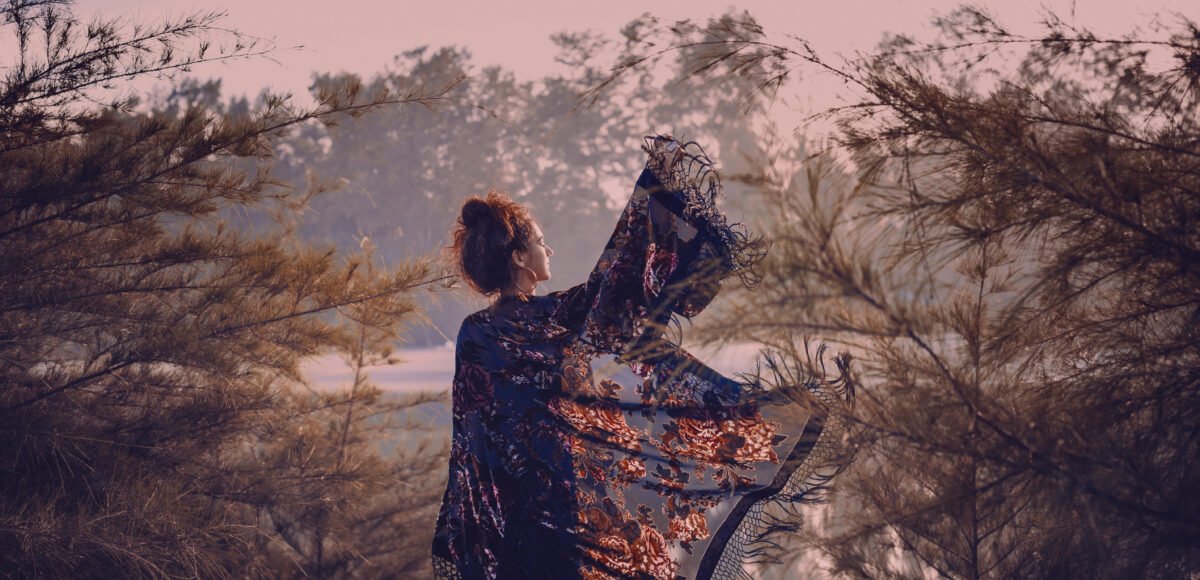Unless you’ve been hiding under an upturned cauldron somewhere, you might have noticed that witches are having a moment! A huge moment! A “you-can’t-buy-this-kind-of-positive-publicity” kind of moment that started a few years ago and doesn’t show any sign of letting up. As a woman who has identified as a witch since the ‘80s, I’ve seen witchcraft go from something that was hidden, feared, woefully misunderstood, and not even legally recognized as a religion, to become one of the fastest growing spiritual movements in the U.S. In fact, researchers estimate that there are 1.5 million Americans that identify as either Pagan or Wiccan, a number that surpasses the number of Presbyterians in this country. The occult isn’t so occult anymore.
While some folks complain about the “commodification” of witchcraft, I see witchcraft going mainstream as a positive. It’s an antidote to the anxiety of the past that kept many of my witchy siblings (witchlings?) in the broom closet, fearful that their beliefs would cause them to lose their jobs, have their children taken away, be classified as mentally ill, or be terrorized or even physically attacked. While we aren’t yet at the stage where witches everywhere feel completely safe, the direction that we are moving gives me a heart full of hope and happy feelings of love and support to all the new witches coming into the fold.
We Have Always Been Here
The fact is that, while witchcraft feels very of-the-moment, it’s actually been around for millennia. If the definition of a witch is someone who casts spells, then witches pre-date all the major religions of the world and even written history itself. People have been using incantations, creating potions to harm or heal, and telling fortunes since ancient times and the people who practiced these arts were seen as assets to the community. In fact, in many cultures around the world, magic practitioners have continued to pass on their traditions and teach their practices uninterrupted, however, that wasn’t the case for European witchcraft.
Although people have been practicing witchcraft forever, it wasn’t until the Middle Ages in England that the word “witch” was first recorded and European people began to see witches as dangerous. After all, if you’re trying to control a population, you want to maintain a hierarchical structure. Allowing independent outliers to have power just won’t do. And so, witchcraft became a threat to the established order that needed to be put down.
Women, and some men, were suspected of being witches and became targets of terrorism. For 300 years, from about 1450-1750, in Western Europe and the British colonies here in the states, anywhere from 40,000 to 100,000 people, mostly women, were executed for the crime of being witches in a mass hysteria called “The Burning Times.” Virtually all women were seen as a potential threat. Women who were herbalists, healers, and midwives were definitely suspect. Women who were too intelligent, not intelligent enough, too powerful, or not powerful at all, too beautiful, or not appealing, could be seen as questionable. Women who were disenfranchised, mentally ill, or too rebellious were accused of witchcraft too. Let’s not forget that even Saint Joan of Arc, a fervent Christian, was burned at the stake for being a witch simply for the fact that she wore men’s clothing.
This centuries-long patriarchal terrorism was enough to relegate witchcraft, spell casting, and feminine power to the fringes of society where it remained hidden and “occult” until the 20th century.
20th Century Witches
As magic went underground, the old folk magic continued to be practiced, often dressed in a thin veneer of the dominant religion or cloaked as cultural activities (these activities were definitely not spiritual. Nope. No way. Uh-uh.) However, buoyed by the expansion of 19th century Spiritualism and new religions like Theosophy, as well as esoteric orders such as The Hermetic Order of the Golden Dawn, the Ordo Templi Orientis, and the Rosicrucians as well as secret societies such as the Freemasons, intrigue in witches and witchcraft began to bubble like a delicious witches’ brew.
In the middle of the 20th century, an Englishman named Gerald Gardner developed a new form of the “old religion” that he called Wicca, with its adherents being called “witches.” His choice in calling his religion Wicca, was not happenstance. The word “witch” comes from the Old English word “wicce” (originally pronounced “WITCH-ay”) and is the root of the name of his religion “Wicca” (pronounced “WICK-uh”). These words are believed to stem from “to know” or “to shape,” and it is often pointed out that knowing the workings of the spiritual realm and shaping reality to your desire are the basics of witchcraft. Although not all witches follow Wicca, Gardner’s melange of Freemasonry, Rosicrucianism, and ceremonial magic has influenced much of what we consider witchcraft today.
While Gardner and others were reimagining witchcraft, another related set of religions were rising up from the utopian mystical counter-cultures of the 19th century. In the 1960s and ‘70s, wider freedom of religious beliefs and back-to-the-land movements fed into interest in more earth-based and nature-connected religions of the past. These reconstructed or reimagined polytheistic nature-based religions began to identify as Neopagan or Modern Pagan with many of the adherents practicing magic and identifying as witches.
So what is a modern witch? A witch is a person (female, male or non-binary) who practices magic, whether as part of a formal religion or not. While Wicca and Neopaganism have witchcraft and magical practices at their center, not all witches today are Wiccans or Neopagans. Witches can be of any religion or even no religion at all. Witchcraft, at its heart, is the practice of magic – a practice that can be incorporated into any religion that doesn’t outright forbid it. In fact, I like to say that we all practice magic whether we identify as witches or not. Anytime you throw a coin in a fountain, walk around a ladder to avoid bad luck, say a prayer to a deity to ask for a favor, or speak an affirmation, you are doing a spell.
Which Witch is Which?
Modern day witches are as varied as music fans. Just as one music fan might love rap and another adore pop music, the umbrella title of “witch” is used to describe anyone from a person who reads their horoscope and casually places crystals on their nightstand, to an initiated third-degree high priestess. The title of “witch” is not one-size-fits-all. Not all witches are the same or practice the same, so understanding the different practices is helpful for understanding which witch is which. What makes a person a witch is that they call themselves a witch. And for those who call themselves witches, there are so many delightfully different witchy paths to choose from.
Hereditary Witch
A hereditary witch comes from a family where magic was practiced and traditions were taught from parent or grandparent to child. Hereditary witchcraft almost always comes from folk magic practices that may or may not have been called “witchcraft” outright. Like practices such as African-American Hoodoo, Mexican-American curanderismo, Appalachian granny magic, Ukrainian Baba Szeptucha, Italian Stregheria, Romani magic, North Asian shamanism, hereditary witchcraft is something that is passed down from elders to the young. Each family’s practices have their own flavor, rituals, and belief systems, often co-existing side-by-side with other more mainstream religious practices.
Traditional Witch
A traditional witch is a designation for someone who looks to the “old ways,” using historical context for their witchcraft and practices. They may research and look for documentation of old practices such as seasonal celebrations or folk magic practices that have been documented by historians and ethnographers to recreate or reinterpret these practices. Just as each culture and time period has had ways of doing magic, there are traditional witches who research and find their own path and those who follow initiated paths such as Cochran’s Craft, Sabbatic Craft or the Feri Tradition. Either way, the traditional witch looks to witchcraft sources that pre-date Gardnerian Wicca.
Solitary Witch
While many witchcraft paths incorporate group rituals or covens, a solitary is a witch of any path or tradition who practices on his, her or their own. This solitary path can be by choice or because she, he, or they haven’t found other witches to work with. Some witchcraft paths such as the green witch or hedge witch paths lend themselves to solitary witchcraft, while witchcraft traditions that require initiation or group rituals are much more challenging to engage with as a solitary. Solitary practitioners often find books and workshops helpful for building their practice and their witchcraft skills.
Kitchen Witch
Kitchen witches, or hearth witches, are witches who strive to integrate magic into their daily routine. They look at the mundane aspects of the day that are centered in and around the home, and look for ways to bring magic into them. This mental shift allows them to turn their everyday items into magical tools and their home into their sacred space. Kitchen witch practices include magical cooking, brewing, gardening, and magical and medical herbalism. They see the power of mindfully attending to these daily activities and adding spiritual intentions to these simple acts. Kitchen witches see the magic of decorating and crafting in the home and may make their own ritual tools so that they can imbue them with their energy. Kitchen witch rituals may include homey things like family gatherings, honoring seasonal changes, and blessing the home.
Hedge Witch
Hedge witches have practices that are closely related to traditional shamanism. In the old days, they would have been the village cunning man or wise woman, living outside of the general community, but providing their neighbors with healing herbs and remedies. They identify closely with the natural world and practice what is known as “hedge jumping,” moving between the familiar and the wild, between this world and the spirit realm. Hedge witches communicate with the natural world of plants and animals, and the world of spirits and the supernatural. Many hedge witches are solitary witches, preferring to learn on their own and not within a coven, and to gain their magical knowledge independently. This makes sense as many of their practices, such as astral projection, animal communication, and wildcrafting, are best when done alone.
Ceremonial Witch
Ceremonial witches practice high magic or ritual magic and follow formal magical paths with elaborate and complex rituals. They belong to organizations such as The Hermetic Order of the Golden Dawn, Ordo Templi Orientis, and the Builders of the Adytum, which have initiations, degree ceremonies, and a hierarchy similar to organizations such as the Freemasons. Ceremonial witches may be interested in esoteric magical practices such as astrology, kabbalah, Enochian magic, and sex magic.
Green Witch
Green witches are highly attuned to the earth and harnessing her energy for magical purposes. Similar to hedge witches and kitchen witches, they may garden and grow their own flowers, trees, herbs, fruits and vegetables for magical purposes. Most green witches also have deep ties to the wild and connect with the land where they live and practice magic with indigenous plants. Green witches primarily use plants for their spell work and are spiritually influenced by nature, the seasons, and the interconnectedness of the natural world.
Eclectic Witch
Eclectic witches are not tied to one particular path. The eclectic witch find truths in many spiritual paths and pulls from these practices what feels true and right to them. This intuitive selection of many truths from many sources leads to a highly personalized path. No two eclectic witches have the same set of beliefs; each path is unique to the individual. Some eclectics practice as solitary witches while others gather for ritual with other open-minded souls, but all eclectic witches are self-directed individualists who are unafraid to blaze their own trails.
Secular Witch
Not every witch worships a god and a goddess. Secular witches are witches who do not worship a deity or deities in their spiritual practice. They see the power of their magic as either coming from within themselves or coming from an impersonal identifiable power such as nature or the “life force.” Sometimes called atheist witches, secular witches can practice other forms of witchcraft that do not depend on the worship of deities, such as Green Magic or Kitchen Witchery.
This “witch list” is by no means complete and is definitely open for interpretation. Even if you don’t identify as a witch, you might see a little bit of yourself in one of these witchy paths. Throughout history, witches have always been interesting and unique individuals: free-spirited, brave, groundbreaking and empowered. There’s no doubt that we will see more interpretations of witches and witchcraft as this spiritual group grows. Hey, maybe you’ll invent the next new witchy flavor!







